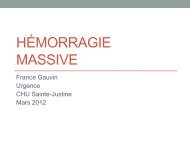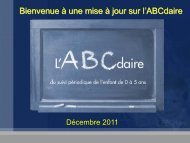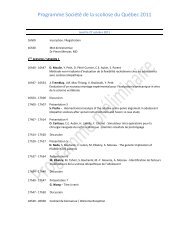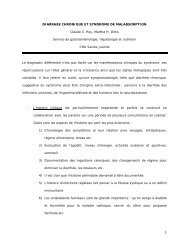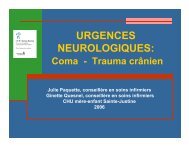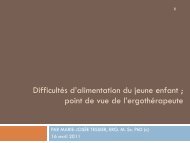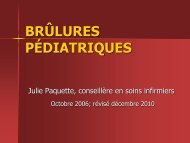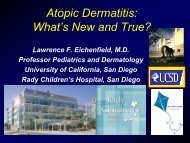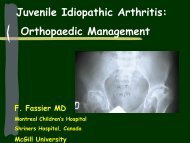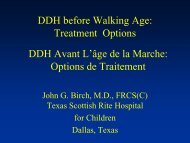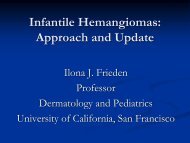Nevus Sebaceous, Epidermal Nevi, and Epidermal Nevus Syndrome
Nevus Sebaceous, Epidermal Nevi, and Epidermal Nevus Syndrome
Nevus Sebaceous, Epidermal Nevi, and Epidermal Nevus Syndrome
- No tags were found...
You also want an ePaper? Increase the reach of your titles
YUMPU automatically turns print PDFs into web optimized ePapers that Google loves.
<strong>Nevus</strong> <strong>Sebaceous</strong>, <strong>Epidermal</strong><strong>Nevi</strong>, <strong>and</strong> <strong>Epidermal</strong> <strong>Nevus</strong><strong>Syndrome</strong>9 th Sainte-Justine Pediatric Dermatology DayNovember 18, 2011Moise L. Levy, M.D.‘Specially for ChildrenDell Children’s Medical CenterAustin, TX
Potential Conflicts of Interest‣ Investigator, Consultant, or Speaker for:-Stiefel/GSK-Galderma-Topaz-Coria-Pierre-Fabre‣ None should apply for this presentation
<strong>Nevus</strong> <strong>Sebaceous</strong>‣ Congenital… some said to develop later‣ Growth around puberty‣ 0.3 % - 0.4 %‣ Malignant risk ???-Trichoblastoma, Syringocystadenomapapilliferum, other adnexal tumors
<strong>Nevus</strong> <strong>Sebaceous</strong> –Malignant Risk‣ 0-2.7 %; 0.8 % ; 2.2% BCC‣ SCCA‣ <strong>Sebaceous</strong> CA‣ PTCH deletions found in some NS lesionsPediatr Dermatol 2009;26:676; Dermatol Surg 2004;30:1546; EurAcad Derm Venereol 2002;16:319; Pediatr Clin N Am2010;57:1177
<strong>Nevus</strong> <strong>Sebaceous</strong> –Malignancy‣ Some publications w/o any BCC inexcised NS‣ 18 yr retrospective of excised lesions‣ 651 lesions/631 patients‣ 0.8% BCC‣ 1.1% Syringocystadenoma papilliferumPediatr Dermatol 2009;26:676
<strong>Nevus</strong> <strong>Sebaceous</strong> –Malignancy‣ Retrospective study of excised NS x 20yrs‣ Included pts with <strong>Epidermal</strong> <strong>Nevus</strong><strong>Syndrome</strong> (Schimmelpenning)‣ 226 pts- 5 with BCC, 2.2 %‣ Recommendation for clinical f/uEur Acad Dermatol Venereol 2002;16:319
<strong>Nevus</strong> <strong>Sebaceous</strong> - Malignancy‣ 4,923 cases NS (1932-2010)‣ 16% benign tumors‣ 8% malignant (0-22); no determination ofmis.diagnosis‣ Suggestion of discussion withfamily/patient regarding excisionPediatr Dermatol 2011 Oct 13.doi:10.1111/j.1525-1470.2011.01562.x.
<strong>Nevus</strong> <strong>Sebaceous</strong> –Management‣ Discussion of low malignant risk withparents, patients‣ Excision (? Indication)-General anesthesia-Local anesthesia-Size, Location‣ Clinical f/u
<strong>Epidermal</strong> <strong>and</strong> <strong>Sebaceous</strong> <strong>Nevi</strong>‣ “Organoid” nevi‣ <strong>Epidermal</strong> with differentiationtoward “epidermal” structures(primarily)‣ <strong>Sebaceous</strong> with differentiation toward“sebaceous” structures (primarily)
<strong>Epidermal</strong> <strong>Nevi</strong>‣ Usually congenital; may appear later‣ Growth/Extension during childhood, puberty‣ Most occur without concern forassociated findings‣ Histology usually non.specific-Like seborrheic keratosis-Approx 1/3 with FGFR3 mutations-May see epidermolysis ( risk ofEpidermolytic ichthyosis)‣ Variants; ILVEN, <strong>Nevus</strong> comedonicus, others
<strong>Epidermal</strong> <strong>Nevus</strong> <strong>Syndrome</strong>‣ <strong>Epidermal</strong> nevi <strong>and</strong> other organ systeminvolvement-Neurologic-Ophthalmologic-Skeletal (15%-70%; Craniofacial 30%)-Cardiac-Renal-Hypophosphatemic Vit D Resistant Rickets‣ Many variants; Proteus, CLOVE,Phakomatosis Pigmentokeratotica, others
Case History‣ 10 y/o female seen for evaluation of congenital skinlesions‣ Sickle-thal trait‣ Prior diagnosis of IP‣ On 1, 25 (OH) 2 D 3 for “rickets”‣ Contralateral m<strong>and</strong>ibular cysts‣ PHEX (-); Mutation assoc w/hypophosphatemic Vit DResistant Rickets (Phosphate Endopeptidase Homologon X-chromosome)‣ FGF-23 elevated
Am J Med Genet 2005;139A:67
<strong>Epidermal</strong> <strong>Nevus</strong> <strong>Syndrome</strong>& Rickets‣ ?Tumor-induced osteomalacia (TIO)‣ Usually associated with benign lesions <strong>and</strong> renal wasting of P <strong>and</strong>low calcitriol-Reports of reversal with removal of tumors‣ Elevated FGF-23 in hypophosphatemic rickets w/o focal bonedisease (blunts Vit D synthesis <strong>and</strong> P resorption)-elevated in pt reported w/focal disease*-@ high levels, cross reacts w/ FGFR 2 (bone), 3 (renal tubules)(craniosynostosis)**Am J Med Genet 2005;139A:67*J Craniofac Surg 2009;20:439**
Proteus <strong>Syndrome</strong>‣ <strong>Epidermal</strong> <strong>Nevus</strong>‣ Progressive/Asymmetric limb overgrowth‣ Vascular malformation, usu CM‣ Fatty overgrowth or Atrophy (ellatoproteus)
Proteus <strong>Syndrome</strong>‣ NIH diagnostic criteria‣ Lipomas, Vascular malformations, Plantar cerebriformconn tiss nevi, Epid nevi, Lipohypoplasia, Dermalhypoplasia‣ PTEN association does not apply‣ 26/29 with AKT1 somatic mutation-oncogene encoding AKT1 kinase (cellproliferation/apoptosis (NEJM 2011;365:611)
CLOVE <strong>Syndrome</strong>‣ Congenital Lipomatous Overgrowth,Vascular Malformation, <strong>Epidermal</strong> <strong>Nevi</strong>‣ Proportionate overgrowth‣ Risk of central/thoracic phlebectasia <strong>and</strong>pulmonary embolism (PE)-12 pts with CLOVE; 11/12 with phlebect.-2/11 with perioperative PE; one deathJ Thor Cardiovasc Surg 2010;140:459
<strong>Epidermal</strong> <strong>Nevus</strong> –Evaluation‣ None if pt is clinically w/o other systeminvolvement; Not clear that extent impt.‣ Neurologic, Ophthalmologic examinations‣ Skeletal survey‣ Serum/urine Ca/P‣ PTH‣ ?FGF23, FGF2R‣ Consider preop eval <strong>and</strong> prophylaxis(CLOVE)
<strong>Epidermal</strong> <strong>Nevi</strong> –Management‣ None‣ Emollients‣ Topical retinoids, Ammonium lactate‣ 5-FU; alone or in combination w/ retinoid‣ Excision‣ LaserPediatr Clin N Amer 2010;57:1177; JAAD1994;30:287; JAAD 2000;43:129; Ann PlastSurg 2001;47:285
<strong>Sebaceous</strong>/<strong>Epidermal</strong> <strong>Nevi</strong> –What I do‣ Consider association with other findings, ifany (? Relation to extent… )‣ Discuss low malignant risk with either‣ Ask family members/patients‣ Most NS excised for cosmetic reasons‣ For EN; emollients, topical retinoids,rarely systemic retinoids, selectiveexcision, or laser



